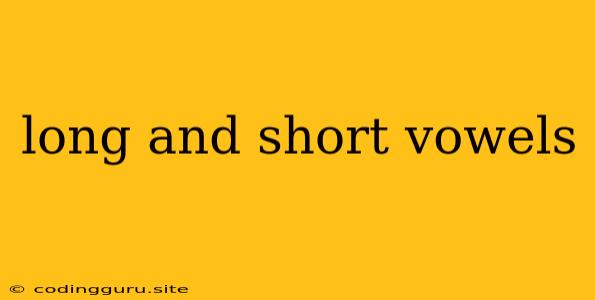Understanding Long and Short Vowels: A Comprehensive Guide
The English language is a fascinating beast, full of quirks and complexities. One of these complexities lies in the pronunciation of vowels, specifically the difference between long vowels and short vowels. This distinction can significantly impact how a word is pronounced and understood. Let's delve into the world of long vowels and short vowels and unravel their secrets!
What are Long Vowels?
Long vowels are a type of vowel sound that is typically pronounced longer and more drawn out than their short vowel counterparts. They are often represented by the same letters as their short vowel counterparts, but with an added diacritical mark, such as a macron ( ¯ ) or a colon (:). For example, the long vowel sound of the letter "a" is often represented as "ā" or "a:", while the short vowel sound of the letter "a" is simply represented as "a".
What are Short Vowels?
Short vowels, on the other hand, are pronounced more quickly and sharply than their long vowel counterparts. They are typically represented by a single vowel letter, without any diacritical marks. For example, the short vowel sound of the letter "a" is represented as "a", while the long vowel sound of the letter "a" is represented as "ā" or "a:".
Key Differences between Long and Short Vowels
Here's a table summarizing the key differences between long vowels and short vowels:
| Feature | Long Vowels | Short Vowels |
|---|---|---|
| Pronunciation | Longer, drawn out | Short, sharp |
| Representation | Often with diacritical marks (ā, a:) | Single vowel letter |
| Examples | "ā" in "fate", "a:" in "car" | "a" in "cat", "i" in "bit" |
How to Identify Long and Short Vowels
Identifying long vowels and short vowels can be tricky, especially for learners of English. Here are a few tips:
- Look for Vowel Combinations: Long vowels are often formed by vowel combinations, such as "ai" in "rain", "ee" in "see", "oa" in "boat", "ue" in "true", or "ow" in "cow".
- Pay Attention to the Letter "e" at the End of a Word: The silent "e" at the end of a word often indicates a long vowel sound, as in "make", "hope", and "bite".
- Context is Key: The sound of a vowel can change depending on the surrounding letters. Practice recognizing the common patterns of long vowels and short vowels in different contexts.
Examples of Long and Short Vowels
Here are some examples of words containing long vowels and short vowels:
Long Vowels:
- ā (as in "fate", "cake", "name")
- ē (as in "see", "tree", "these")
- ī (as in "bike", "time", "kite")
- ō (as in "go", "toe", "show")
- ū (as in "flute", "tune", "mule")
Short Vowels:
- a (as in "cat", "hat", "man")
- e (as in "bed", "get", "pen")
- i (as in "bit", "fit", "pin")
- o (as in "hot", "lot", "dog")
- u (as in "cup", "but", "sun")
Importance of Understanding Long and Short Vowels
Understanding long vowels and short vowels is crucial for several reasons:
- Accurate Pronunciation: Correctly identifying and pronouncing long vowels and short vowels is essential for clear and accurate speech.
- Improved Reading Skills: Being able to recognize long vowels and short vowels in written words helps improve reading fluency and comprehension.
- Enhanced Spelling: Understanding the relationship between vowels and their sounds can contribute to better spelling skills.
Conclusion
Long vowels and short vowels are fundamental components of the English language. By understanding their differences and how they are represented, you can significantly improve your pronunciation, reading, and spelling skills. Continue practicing, explore the fascinating world of vowels, and unlock the secrets of the English language!
